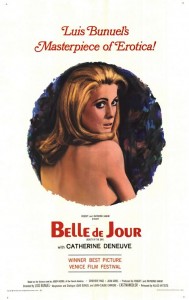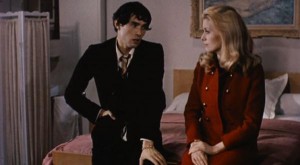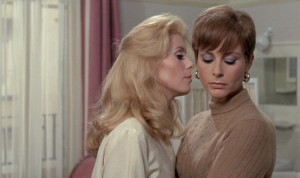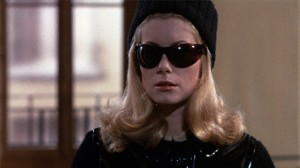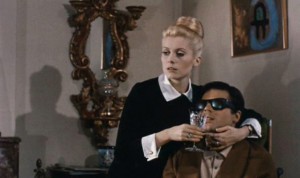Luis Bunuel:
“Sexual desire has to be seen as the product of centuries of repressive, emasculating Catholicism. It is always colored by the sweetest secret of sin.”
Grade: A (***** out of *****)
The great Spanish filmmaker Luis Bunuel preferred not to comment about his films, leaving it up to his audiences as to how to perceive and interpret them. But when he did, he delighted in making his work even more thematically ambivalent and morally ambiguous. “It’s a secretive film,” he said about Belle de Jour, his shockingly erotic fantasy, “in which nothing is immediately obvious or apparent.”
A film of spectacular beauty and complex ambiguity, “Belle de Jour” is one of the most accessible and widely seen masterworks of the surrealist cinema. It’s a feature in which the realms of reality and dreams form one inseparable world.
Belle de Jour, which deservedly won the top prize, the Golden Lion, at the 1967 Venice Film Fest, began the last, most creative and, ironically, most commercial chapter of Bunuel’s long and brilliant career; he died in 1983, six years after his last film, The Phantom of Liberty.
Based on the 1929 novel “Belle de jour” by Joseph Kessel, the film is about a young woman who spends her midweek afternoons as a prostitute, while her loving husband is at work as a doctor.
 The title of the film is a pun in French. The phrase “belle de nuit,” could be translated as “lady of the night,” i.e. a prostitute. It may also refer to the French name of the lily (Hemerocallis), “beauty of the day,” a flower that blooms only during the day.
The title of the film is a pun in French. The phrase “belle de nuit,” could be translated as “lady of the night,” i.e. a prostitute. It may also refer to the French name of the lily (Hemerocallis), “beauty of the day,” a flower that blooms only during the day.
Buñuel’s first color film is also his most commercially successful, grossing over $20 million worldwide. It’s still one of the most famous erotic and surrealistic features ever made
Bunuel did not particularly like Kessel’s novel, as he observed: “I found it interesting to try to turn something I didn’t like into something I did. There are some scenes in the film, which I’m very pleased with, and others with which I am not at all. But I ought to say I enjoyed total freedom during the shoot and I therefore consider myself entirely responsible for the result.”
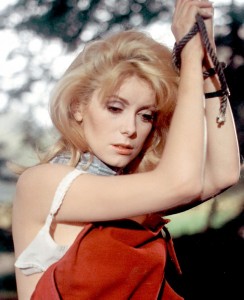 For this picture, Bunuel received a bigger budget than the usual, which is reflected in the polished production values, specifically costume design. Many of the costumes of Deneuve who changes hair style and dress in every scene, were designed by Yves St. Laurent.
For this picture, Bunuel received a bigger budget than the usual, which is reflected in the polished production values, specifically costume design. Many of the costumes of Deneuve who changes hair style and dress in every scene, were designed by Yves St. Laurent.
The film concerns the masochistic impulses of a beautiful young married woman, played by Catherine Deneuve, in one of her finest and most enigmatic performances. Severine, the beautiful young wife of a handsome and wealthy surgeon Pierre (Jean Sorel), loves her husband deeply, but she is always frigid when lying in his arms; they sleep in separate beds.
Pierre remains kind, considerate and polite throughout, but, occasionally when he touches her and expresses a wish to have a child, she literally freezes, claiming she has a headache, or not ready yet for physicality.
Consumed by guilt, Severine develops a masochistic urge to be sexually assaulted and decides to work part-time in a small, clandestine, and elitist brothel, catering (illegally) to wealthy patrons with specialized sexual tastes. She spends her afternoons as fetish and fantasy object to an assortment of strange clients, including aJapanese with the mysterious box.
One of the patrons, Marcel (Pierre Clementi), is a young, self-indulgent hoodlum. Severine finds herself falling in love with him in spite of–or because of–his sadistic handling of her
Severine’s fantasies of humiliation escalate until she and we can no longer distinguish illusion from reality. The lines dividing “objective” reality, what actually happens to the heroine, the heroine’s subjective world, her imaginary fantasies and morbid impulses are never clear.
Bunuel’s wry and disturbing tale centers on a virginal newlywed who works the day shift in a high-class Parisian brothel, unbeknownst to her patient, kind husband.
The beginning of the film is visually brilliant, shocking and disorienting—by design. Severine is riding with Pierre through their elegant country estate in a landau accompanied by coachmen. At Pierre’s command, they stop, leading Severine into the woods, where they strip her dress, tie her to a tree, and whip her.
The landau, a symbol of the irrational, becomes a motif, when later on Severine is hired for an assignation with a patron who suffers from necrophilia. The movie is a catalogue of fetish objects that recur in Bunuel’s films, such as boots, whips, chords, and chains.
Like other Bunuel’s films, social class figures prominently, here in Severine’s visions of being whipped, violated and covered with mud by her servants.
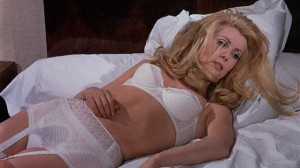 But just when we assume that Severine is a masochist, she begins to inflict the same kinds of punishments on her clients, including the surgeon. (It is possible that Cronenberg’s depiction of the gynecologists in “Dead Ringer” was influenced by Bunuel’s picture).
But just when we assume that Severine is a masochist, she begins to inflict the same kinds of punishments on her clients, including the surgeon. (It is possible that Cronenberg’s depiction of the gynecologists in “Dead Ringer” was influenced by Bunuel’s picture).
Bunuel’s “straight” treatment of shocking material belies the wit of his script. Unavailable for two decades, “Belle de Jour” was re-released theatrically several times, shocking viewers of the 1980s and 1990s in the same way that it did when it first scandalized the bourgeois and movie worlds in the late 1960s.
Deneuve is perfectly cast as the sexually frigid Severine, a woman unable to share physical intimacy with her husband, despite declarations of genuine love. Deneuve’s extraordinary beauty, cool attitude and remoteness suit the film’s tone perfectly.
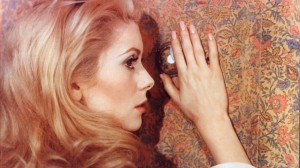 “Belle De Jour” is one of Deneuve’s best films, released at the first (of several) career heights, right after Jacques Demy’s original musical, “Les Demoiselles de Rochefort” and “The Umbrellas of Cherbourg,” and alongside Roman Polanski’s “Repulsion.”
“Belle De Jour” is one of Deneuve’s best films, released at the first (of several) career heights, right after Jacques Demy’s original musical, “Les Demoiselles de Rochefort” and “The Umbrellas of Cherbourg,” and alongside Roman Polanski’s “Repulsion.”
Novelist Kessel admired the film, noting: “Bunuel’s genius has surpassed all that I could have hoped. It is at one and the same time the book and not the book. We are in another dimension, that of the subconscious, of dreams and secret instincts suddenly laid out.”
Detailed Plot (Scene by Scene)
While visiting a ski resort, Severine and her husband Pierre meet two friends, Henri Husson (Michel Piccoli) and Renée (Macha Méril). Séverine does not like Husson’s manner and the way he looks at her. Back in Paris, Séverine meets up with Renée and learns that a mutual friend, Henriette, now works at a brothel.
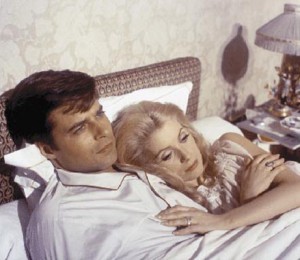 At her home, when Séverine receives roses from Husson, she is so unsettled by the gesture that she drops the vase. Rushing into her bathroom, she accidentally drops her eau de cologne.
At her home, when Séverine receives roses from Husson, she is so unsettled by the gesture that she drops the vase. Rushing into her bathroom, she accidentally drops her eau de cologne.
At the tennis courts, she meets Husson and they discuss Henriette and houses of pleasure. Husson mentions a high-class brothel at 11 Cité Jean de Saumur. He confesses desire for her, but Séverine rejects his advances.
Haunted by childhood memories involving her father, Séverine goes to a high-class brothel run by the suave and knowing Madame Anaïs (Geneviève Page), who offers 50/50 for her services. Severine promises to come back at 2pm but insists that she must be home at 5pm sharp, and Anais accepts her conditions.
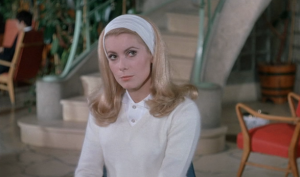 That afternoon Séverine services her first client. Reluctant at first, she responds to the “firm hand” of Madame Anaïs, who names her “Belle de Jour.” After disappearing for a week, Séverine she returns to the brothel and begins working from 2 to 5 each day, returning to her unsuspecting husband in the evenings.
That afternoon Séverine services her first client. Reluctant at first, she responds to the “firm hand” of Madame Anaïs, who names her “Belle de Jour.” After disappearing for a week, Séverine she returns to the brothel and begins working from 2 to 5 each day, returning to her unsuspecting husband in the evenings.
One day Husson comes to visit her at home, but Séverine refuses to see him. Still she fantasizes about having sex with him in her husband’s presence. Ironically, Séverine’s physical relationship with her husband is improving and she begins having sex with him.
Séverine then becomes involved with a young gangster, Marcel (Pierre Clémenti), who offers her the thrills and excitement of her fantasies about. When Marcel becomes jealously demanding and violent, she decides to leave the brothel.
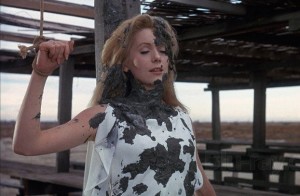 Séverine is concerned about Husson who has discovered her double life. After one of Marcel’s gangster associates follows Séverine to her home, Marcel threatens to reveal her secret to her husband, who he refers to as “the obstacle.”
Séverine is concerned about Husson who has discovered her double life. After one of Marcel’s gangster associates follows Séverine to her home, Marcel threatens to reveal her secret to her husband, who he refers to as “the obstacle.”
Marcel waits downstairs for Pierre to return home and shoots him. Fleeing, he is shot dead by the police. Séverine’s husband survives, but is left in a coma. The police are unable to find a motive for the attempted murder.
Weeks later, Séverine is at home taking care of Pierre, who is completely paralyzed and in a wheelchair. Husson arrives, determined to tell Pierre the truth about her double life. He offers her to be present in “the conversation,” but she refuses, waiting in the living room; we never observe Husson talking to Pierre, so there is no way to know what exactly he had said.
In the last scene, Séverine dreams that her husband is healthy again and they are happy together.
Deneuve is perfectly cast as the sexually frigid Severine, a woman unable to share physical intimacy with her husband, despite declarations of genuine love. Deneuve’s extraordinary beauty, cool attitude and remoteness suit the film’s tone perfectly.
“Belle De Jour” is one of Deneuve’s best films, released at the first (of several) career heights, right after she appeared in Jacques Demy’s original musical, “Les Demoiselles de Rochefort” and “The Umbrellas of Cherbourg,” and alongside Roman Polanski’s “Repulsion.”
Novelist Kessel admired the film, noting: “Bunuel’s genius has surpassed all that I could have hoped. It is at one and the same time the book and not the book. We are in another dimension, that of the subconscious, of dreams and secret instincts suddenly laid out.”
End Note
“Belle De Jour” was re-released theatrically in 1995 by the then Miramax’s specialized division Zoe as “Presented by Martin Scorsese.” Scorsese promoted the limited rerelease and then a 2002 release on DVD.
In 2006, Portuguese director Manoel de Oliveira made “Belle Toujours,” a disappointing film imagining a future encounter between two central characters from the original film.
Cast
Severine Serizy (Catherine Deneuve)
Pierre Serizy (Jean Sorel)
Henri Husson (Michel Piccoli)
Madame Anais (Genevieve Page)
Marcel (Pierre Clementi)
Hippolyte (Francisco Rabal)
Monsieur Adolphe (Francis Blanche)
Charlotte (Francoise Fabian)
Mathilde (Maria Latour)
The Duke (George Marchal)
Credits
France/Italy (Paris Film Production/Five Films Rome)
Produced by Robert Hakim
Directed by Luis Bunuel
Screenplay: Bunuel, based on the novel by Joseph Kessel
Camera: Sacha Vierney
Editing: Walter Spohr
Art direction: Robert Clavel
Costumes: Helene Noury, Yves Saint Lauren
Running time: 102 minutes
